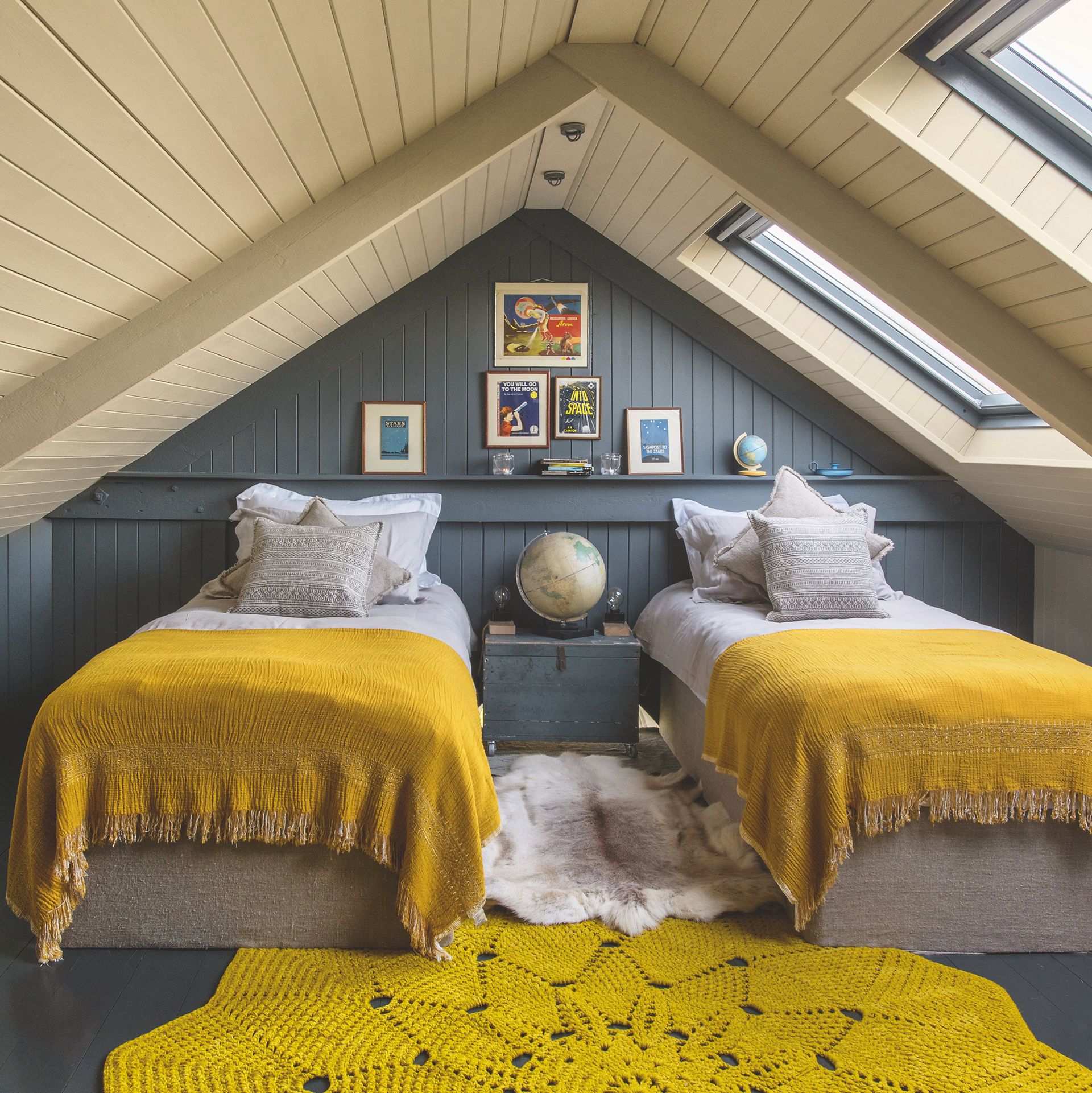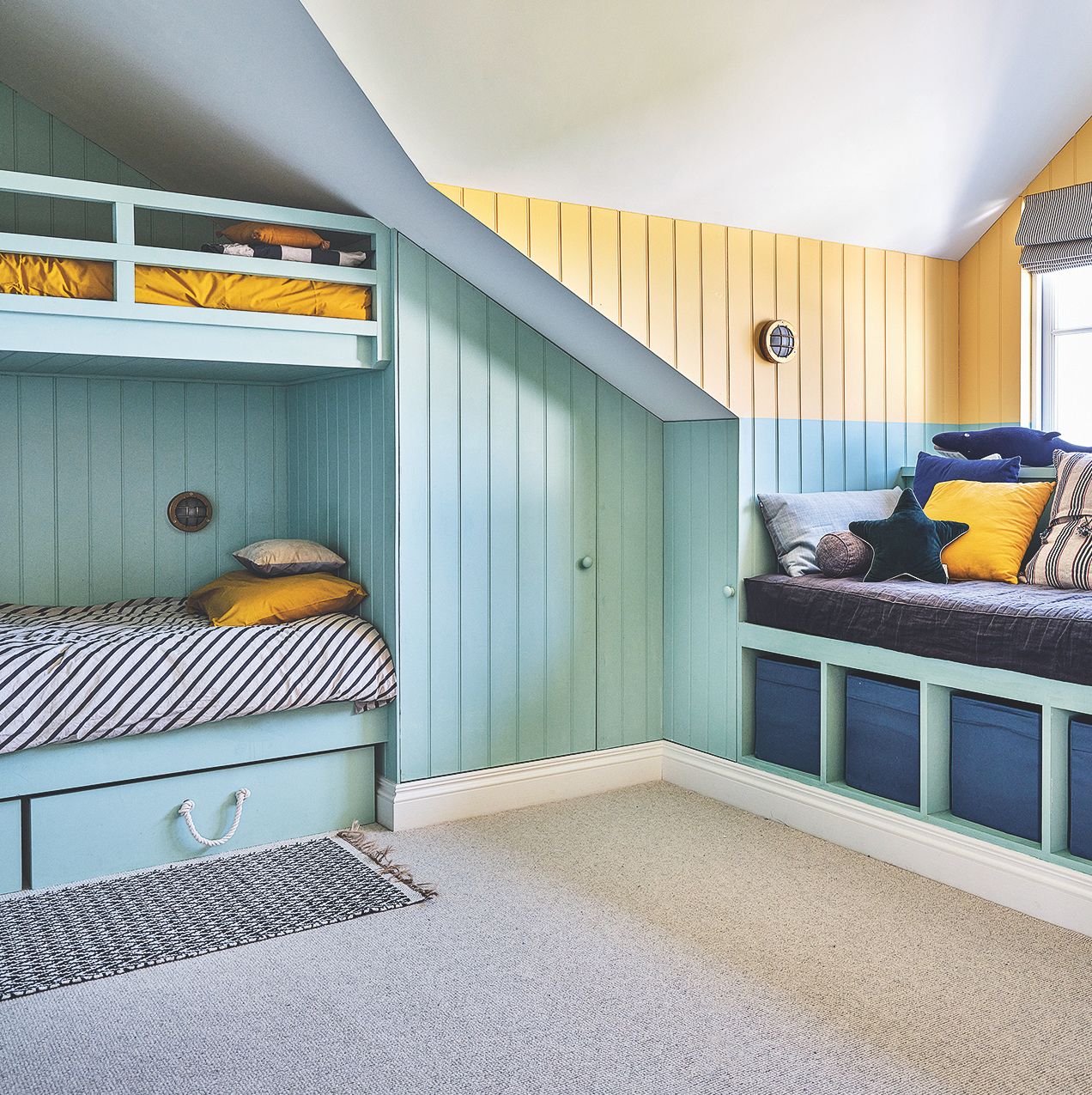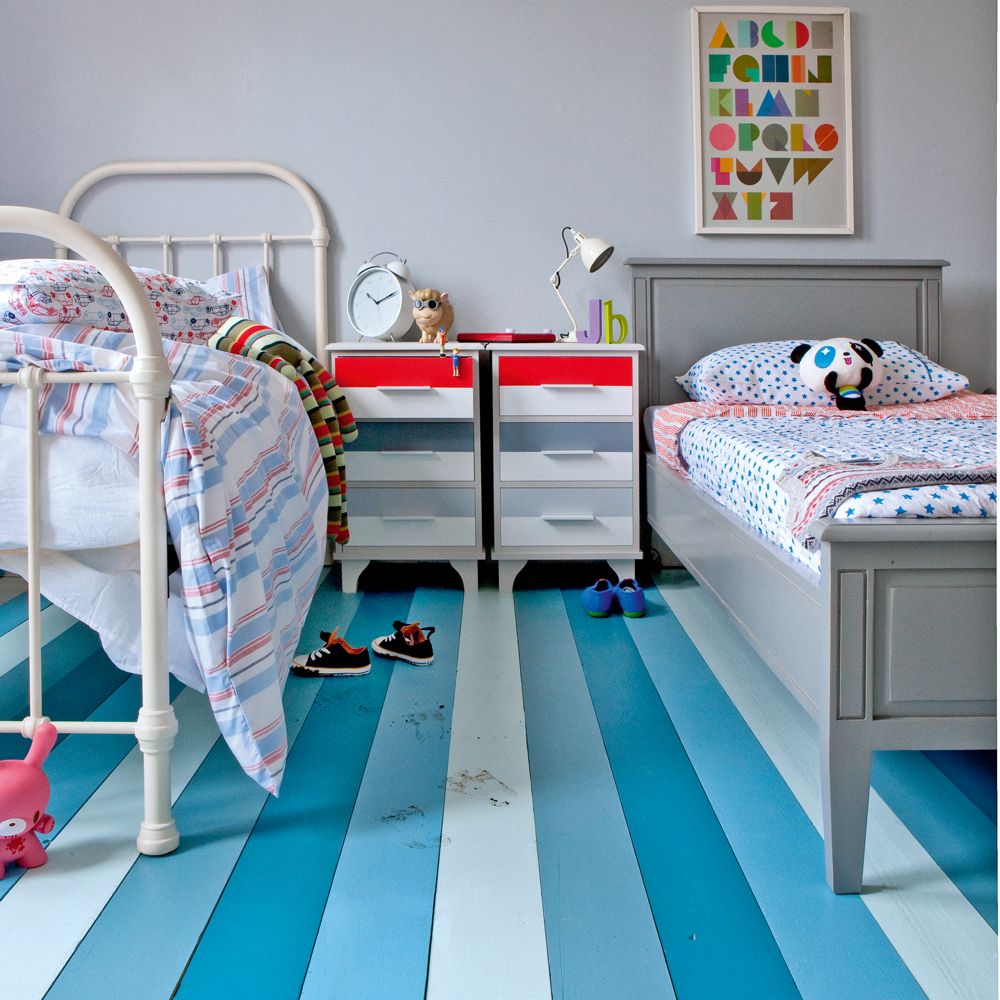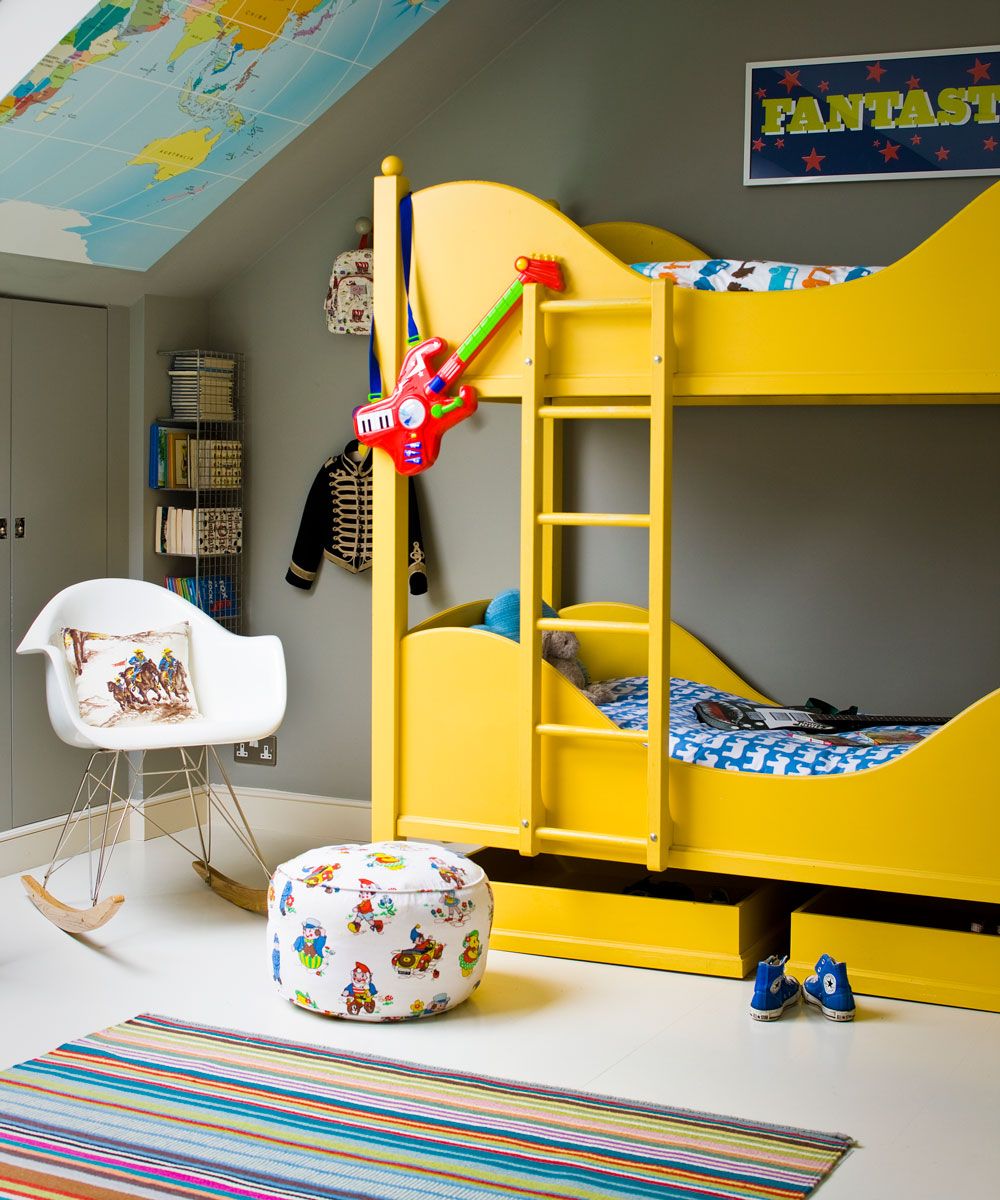Divvy up space for siblings with these clever design ideas for shared bedrooms

Children’s bedrooms are a fun place to decorate, but when planning for siblings, a little more care is required. With space at a premium for many, shared bedroom ideas with two kids in the same room can often be a great solution. Sometimes it’s the only option. Whichever is the case, how you decorate the space can have a big impact on how siblings will interact with each other.
Stop resentments in their tracks with kids bedroom ideas that are fair and take both children into account. Forget preferential treatment based on age or sex, and give each child similar amounts of space and storage.
Encouraging kids to share and be patient with each other with these shared bedroom ideas, will benefit their development and lead to a happier, more harmonious household.
We’ve pulled together a few simple children’s shared bedroom ideas to help keep the peace and make sure both your kids feel represented in their shared room.
From decor ideas to divvying up floor space and allocating storage, these shared bedroom ideas will help to keep the peace and provide a comfortable place for kids to relax, play and sleep.
1. Divide the space equally

(Image credit: Future / TBC)
Treating children equally will diffuse resentments before they start. So ensure each child has the same amount of space, regardless of age or other factors.
If you’re including beds with built-in storage beneath, make sure you know which side the drawers will open. It will reduce any arguments and make life easier if drawers can be opened without encroaching on each other’s space.
2. Include built-in storage where possible

(Image credit: Future / Dan Duchars)
Kids accumulate a lot of ‘stuff’. From clothes and shoes, to toys, books, sports kids, dressing up costumes, school work and more. With two kids sharing a bedroom, it’s easy for things to get out of hand, particularly when they grow out of things so fast.
They key to keeping things organised and under control is ample storage. Built-in or bespoke options will make the most of every centimetre. So it’s well worth considering the extra expense, especially in an attic bedroom or one with with awkward corners and angles. If you can stretch to the initial outlay, it will pay off in the log run, as it won’t be necessary to replace small freestanding pieces with larger ones down the line.
Make sure drawers and cupboard space are divided up, so each child knows which is his or her section and they can find their own stuff. Some shared areas may be necessary for toy storage ideas, so ensure they are aware of this, with labels if necessary.
3. Choose a calming colour scheme

(Image credit: Future / James Merrell)
Colour affects our mood and how we feel, so to keep kids feeling calm, avoid a sensory overload of garish primary colours in their bedroom. Toys, books and games will keep them stimulated, so it’s good to temper this with a backdrop of serene neutrals and gentle pastels in their space.
‘Personality can be added without altering the décor through photographs and other items being hung on the wall,’ says Georgia Metcalfe, founder, The French Bedroom Company(opens in new tab). ‘Remember, plain walls and furniture don’t go out of style and make a room feel bright and airy.’
This is a smart solution in a girl’s bedroom idea if you’re dealing with two very distinct personalities. The calming neutral scheme will be the perfect backdrop for both to express themselves.
4. Be inventive with a bunk bed layout

(Image credit: Future PLC / James French)
Of course, the traditional bunk bed layout is a well designed way to accommodate two kids in a small bedroom. However, it may not work so well for kids of different ages, where their needs vary.
If you have a younger one who still likes bedtime stories and you want to be able to pull up a chair next to the bed, consider an alternative bunk bed layout. This can either be done by an choosing L-shaped model or with a platform bed and a single bed at a 90 degree angle beneath, instead of a desk setup.
5. Make learning fun with a double desk

(Image credit: Future / TBC)
Provide kids with a smart and stimulating shared place to do homework and they’ll be more likely to knuckle down and do it. This is particularly essential for teenage bedroom ideas if they have exams coming up.
Creating an alcove beneath built-in storage is an ideal spot for a double desk. Ensure there’s enough space for both kids to sit and write, draw or do their homework at the same time. And make it fun, with quirky wallpaper that can be coloured in to encourage their creativity when they study alone too.
6. Go for a theme they’ll both love

(Image credit: Future PLC / Carolyn Barber)
Accommodating colours, patterns and themes each kid loves can lead to a messy mishmash of a shared bedroom scheme that suits neither them nor you.
Instead, go for a theme, such as a movie, book, topic or character that they both enjoy and make that the focal point. Setting this within a neutral background will allow each child the space to personalise their section of the bedroom with favourite toys and teddies.
7. Make bedtime appealing with modern design

(Image credit: Future / Brent Darby)
If bedtime in a shared bedroom turns too easily into bickering or play time, make it more appealing with a cocooning modern bunk bed design.
With shelves that can be personalised and its cosy rounded shape, this bunk bed feels more like a den or a place to hang out, where each kid gets their own space to read and relax before lights out.
8. Create a whimsical wonderland

(Image credit: Annie Sloan)
Flex your own creative muscles and embark on a DIY project transforming a shared bedroom into a whimsical wonderland with some sheets of plywood, chalk paint and fabric.
‘If you’re a proficient DIYer, create a gateway to a far-off fantasy land with a piece of plywood cut to size at your local hardware store and painted in contrasting colours,’ says colour expert, Annie Sloan(opens in new tab).
‘Forget gender-typical likes and dislikes, teach them young that every colour is for everyone.
‘Have fun with fabrics; a curtain to pull across the bed creates an instant hideaway. Unexpected upsides can include instilling your child with a strong sense of pride in their own environment.’
9. Pick furniture that will last

(Image credit: Future / Colin Poole)
Vintage pieces by their nature have weathered the years and various design trends. These make a good choice if you want what the furniture you choose to see your little ones through from toddlers to teenagers.
‘To prevent frequent furniture replacing, purchase durable pieces that will stand the test of time,’ says Georgia Metcalfe, founder, The French Bedroom Company. ‘Wardrobes, tables and chests of drawers are key choices. Solid craftsmanship in the design and natural materials are generally a good indicator that the furniture will last.’
10. Include space for soft play areas

(Image credit: Future / Nicholas Yarsley)
Kids love to play on the floor, so whether you’ve gone for carpet, timber flooring or something else, ensure you include a section of floor space for them to play. Ample storage nearby and extra rugs underfoot for their comfort will encourage this.
‘Children’s rooms can be short on space, so it’s vital to get smart with the layout to maximise what’s available,’ says Christopher Lusty, founder, Little Folks Furniture(opens in new tab).
‘Having simple ways to declutter and create floorspace is fundamental to maintaining a harmonious bedroom. Raised bed frames give the option to tuck storage underneath.’
11. Put up diving walls for privacy

(Image credit: B&Q)
B&Q have the ultimate design solution for how to divide a shared kids room. The genius room dividing panels are adjustable to suit all room heights, providing a quicker and cheaper solution than structurally altering a home with a growing family.
Each panel is made out of MDF. The height can be altered to fit any room using the adjustable feet with 4 non-slip pads. Ideal for a teenage girl and teenage boy’s bedroom idea.
12. Cater for different ages in a small room

(Image credit: Little Folks Furniture)
Not all siblings who share a room are of similar ages, so choosing a bed set up can prove tricky – especially when space is limited.
This smart bunk bed design caters for a younger child with an elevated single bed, while providing a small double bed beneath for an older sibling. Space-saving and practical to suit very different ages within the shared bedroom ideas.
13. Paint the walls with multiple colours

(Image credit: Future PLC/ Colin Poole)
If one child is begging for pink walls and the other wants a contrasting colour why not blend both their choices together, creating a colour scheme that keeps them both happy. Rather than painting each wall a different colour why not create a funky geometric design on the walls with the two colours?
Create this diagonal design by running masking tape down the wall to create a sharp line between the different coloured bedroom paint ideas. Finish off the room with room decorations that will appeal to both kids.
14. Divide the room with furniture placement

(Image credit: Future PLC/ Colin Poole)
Having shared bedroom ideas doesn’t mean you can try to create a sense of personal space for each child. In this small kids bedroom idea the beds are placed on opposite sides of the room, to create more personal space for each child.
The chimney breast has been cleverly utilised to give the illusion of a little privacy between the two bed. Anyone who has created a teenage girl bedroom or one for boys will know the importance of privacy in a shared room.
15. Break up the conventional layout

(Image credit: Little Folks Furniture)
Don’t feel like you have to conform with the traditions of having symmetry when it comes to how to divide a kids room bedroom. In fact, mixing up how to arrange furniture in a bedroom can make a big impact on the rooms layout. Rather than seeking symmetry to zone the room for each child the beds are placed almost back to back to dominate one corner – freeing up the rest of the space for their individual needs.
Having the beds facing away from each other helps to give each child a different persecutive, a wall to call their own.
16. Mix and match individual styles

(Image credit: Future PLC/ Paul Raeside)
Your kids may have to share a room, but that’s as far as it has to go. If you have one messy, one tidy, one boy, one girl, one explorer and one ballerina then fill the room with different room accessories and bedding.
Although it’s within shared bedroom ideas you can even go as far as giving them completely different beds and desks, don’t deny them their own style just because they share the same room.
17. Coordinate the bedding

(Image credit: Future PLC/ David Brittain)
18. Welcome a feature wall for storage

(Image credit: Future PLC/ Paul Raeside)
Balance a twin set up with a feature wall for toy storage ideas and bookshelves. The curated wall provides plenty of space for double everything, from baby toys through to artwork and more grown-up accessories.
If you’ve had baby twins then why not keep them together? At a young age, it doesn’t matter if they’re different sexes they can happily stay in shared bedroom ideas. Keep everything multicoloured in animal and alphabet designs which can be updated with pops of pink and blue if you wish.
19. Mismatch sheets and accessories to differentiate

(Image credit: Future PLC/ Tim Young)
If you’ve decided to use matching furniture throughout the room, a simple way of letting your kids show their personality in the room (and keep them separate in the wash) is to let them choose their own bedding.
It is amazing the impact that coloured bedding can have on a room. If your kids have their heart set on a theme in the room, just make sure the bedding centres around it like in this nautical bedroom.
20. Add one harmonious accent colour

(Image credit: California Shutters)
Inject a hit of colour that both children like, to add a harmonious accent colour. A colour such as brilliant yellow will prove timeless as they grow, meaning you won’t need to refresh every year as they grow out of baby pink or baby blue.
Paint window shutter ideas in a striking shade to invigorate the room and highlight the view beyond – encouraging them to look out to a world beyond those four walls.
21. Maximise floor space with bunk beds

(Image credit: Future PLC/ Jeroen Van Der Spek)
Bunk beds make the most out of the floor space in shared bedroom ideas, which is important when you have double the clothes, toys and personality in a room. It also means that siblings can operate in different spheres.
You can now purchase bunkbeds that operate almost like completely separate rooms which is a life-saver for working out how to divide a shared kids room with siblings who can’t quite see eye to eye.
22. Include plenty of desk space for them to work in peace

(Image credit: Future PLC)
Siblings who share rooms have to sleep together, dress together and play together, so it is healthy to give them some space to themselves. Make sure to include choose a desk with plenty of space so they can complete there homework on their own without their sibling pestering them.
This is especially important if there is an age gap between your children, if one is a teenager they need a space that they can leave there revision for any upcoming tests, safe in the knowing it won’t be mistaken as waste paper by their younger brother or sister.
23. Personalise everything

(Image credit: Future PLC)
So you don’t get into ‘but that’s mine‘ arguments, personalise everything where possible. Fun bedroom wall decor, bedding embroidery and even painted signs above each of their beds are all great ways to show the divide in the room, whilst keeping everything else the same.
In shared bedroom ideas, you do run the risk of siblings feeling like they’re unable to express themselves, but with personalisation they can literally stamp there name on everything.
24. Add extra privacy with a tent

(Image credit: Future PLC/ Simon Whitmore)
Every child loves a den but it is a clever addition to a shared bedroom. They can choose to play in the tent together or use it as a space to get away from each other. You can buy indoor children’s tents online, or make one yourself that will fit perfectly into the corner of the room like this one.
This bedroom tent is as simple to create as hanging a sheet over a pole attached to the ceiling and securing it to two point son the wall. All that’s left is to fill it with a cosy rugs and cushions.
25. Create storage for both bunk bed levels

(Image credit: Future PLC/ David Brittain)
The storage for traditional bunk beds is usually found on the bottom level under the bottom bunk. However, shared bedroom storage, even if your two kids are best friends, can be a recipe for disaster. Insert a peg rail next to the top and bottom bunk and hang storage baskets or bags over them like in this room.
This will help keep your kids belongs separate and within easy reach from their bed, just be sure they are within easy reach for you to take down incase you’re called in for any lost plimsoll emergencies.
26. Choose a bespoke bunk bed design for privacy

(Image credit: Future PLC/ James French)
Box bunks are a great way to utilise space – they are much like normal bunks, but provide a little den of personal space. Encourage kids to decorate the inside of their box in their own drawings, artwork and bedding designs whilst keeping everything outside of that space the same.
This bed is perfect for siblings with different tastes as the outside can be painted one colour, but the enclosed insides can be painted to match each child’s interests, combining both boys and girls bedroom ideas. The ledge also provides space for them to display their precious belongings and pictures.
27. Avoid fights with matching beds

(Image credit: Future PLC/ Paul Raeside)
While letting them choose their own bed and furniture works in a perfect world. Sometimes the only way to avoid a sibling fight is to keep everything the same. This usually works best if your children are twins, the same sex and into the same things.
If they aren’t, make sure to stick to neutral bedroom ideas. It makes decorating easy, buying easy and no one can fight over what’s theirs if it’s all the same – but we can’t guarantee that will stop them.








